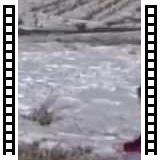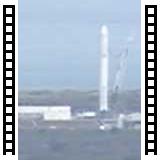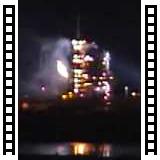 | "Father Of The Space Age" - Dr. Robert Goddard (2011-08-21)      |
 | 5-Segment Solid Rocket Motor DM-1 Test Firing For Ares I Rocket (2011-05-29)      On Sept. 10, 2009, NASA and industry engineers lit up the Utah sky with the initial full-scale, full-duration test firing of the first stage motor for the Ares I rocket. The Ares I is a crew launch vehicle in development for NASA's Constellation Program. ATK Space Systems conducted the successful stationary firing of the five-segment solid development motor 1, or DM-1. ATK Space Systems, a division of Alliant Techsystems of Brigham City, Utah, is the prime contractor for the Ares I first stage. Engineers will use the measurements gathered from the test to evaluate thrust, roll control, acoustics and motor vibrations. This data will provide valuable information as NASA develops the Ares I and Ares V vehicles. Another ground test is planned for summer 2010.
|
 | Big Rocket Explodes! 1/3 Scale Model Mercury-Redstone 3 Blows Up At Launch (2011-05-29)      At LDRS-18 (Large and Dangerous Rocket Ships) in Argonia, Kansas in 1999. This was the annual national rocket launch for the Tripoli Rocketry Association. The largest amateur rocket project was a 1/3 scale model of the Mercury Redstone 3 rocket that Alan Shepard launched in to become America's first man in space in 1961. The launch ignition button was pushed by Alan Shepard's daughter. Very soon thereafter she was glad her dad wasn't on the rocket. At ignition, the solid propellant motor blew through its casing, ruptured and exploded. The explosion destroyed the rocket which snagged itself in its launch tower. The rocket was totally demolished but the Mercury capsule was salvaged for a future project. Always prepare your rocket motors carefully because sometimes they can explode and blow up your rocket!
|
 | Crash and Burn! How NOT To Recover a 42 Foot Tall Half-Ton Rocket (2011-07-02)      At the FireBALLS 5 amateur and experimental rocketry gathering of "large and dangerous" rockets in Nevada, Chuck Sackett launched his pet project, named Project 463. The rocket was 42 feet tall and weight 1200 pounds. The liftoff was beautiful and the rocket soared into the sky... and then came down. Hard! Project 463 failed to deploy its parachutes and became one of the world's largest lawn darts when it plowed nose first into the desert floor. The rocket was destroyed and smashed into hundreds of bits and parts that scattered the area. The motto of this story: ALWAYS doublecheck your recovery system.
|
 | External rocketcam video looking outside during the first Atlas III rocket launch (2011-06-15)      Onboard rocketcam Video during the first launch of the Lockheed Martin Atlas III in May 2000. This is a view outside the rocket, looking down on the launch pad as the Atlas first stage rocket engine ignites and the rocket takes off. As it ascends, you see the flame of the first stage changing shape and color as the atmospheric pressure lowers with the site of the Cape Canaveral range receding into the distance.
|
 | Liftoff! NASA's Wise Spacecraft Launch On Delta 2 Rocket (2011-10-20)      VANDENBERG AIR FORCE BASE, Calif. - NASA's Wide-field Infrared Survey Explorer, or WISE, lifted off over the Pacific Ocean this morning on its way to map the entire sky in infrared light. A Delta II rocket carrying the spacecraft launched at 9:09 am EST from Vandenberg Air Force Base in California. The rocket deposited WISE into a polar orbit 326 miles above Earth about 55 minutes later. Video courtesy NASA TV. www.spaceflightnews.net
|
 | SpaceX Falcon 9 First Launch From KSC VAB Roof (ZOOMED OUT View) (2011-11-19)      This is a "wide-angle" zoomed out view of the SpaceX Falcon 9 rocket's first launch from Cape Canaveral Air Force Station on June 4, 2010. I was fortunate enough to have access to the roof of Kennedy Space Center's Vehicle Assembly Building from where I shot this video. This is one of two videos I took. This was taken with a motionless camera, zoomed out, looking at the launch pad as the Falcon vehicle lifted off. Falcon-9, built by Space Exploration Technologies Corp., flew nearly perfectly. After a 9-minute trip to orbit, the rocket placed a summy mockup of the Dragona capsule spacecraft into low Earth orbit. The flight results were : nominal shutdown and orbit was almost exactly 250km. Telemetry showed essentially a bullseye: ~0.2% on perigee and ~1% on apogee. Go SpaceX! Go Falcon-9!
|
 | SpaceX Falcon 9 First Launch Reaches Orbit (View From KSC VAB Roof) (2011-06-03)      From the VAB roof, this is video I shot of the SpaceX Falcon 9 rocket's first launch from Cape Canaveral Air Force Station on June 4, 2010. I was fortunate enough to have access to the roof of Kennedy Space Center's Vehicle Assembly Building from where I shot this video. This is one of two videos I took. This one is more tightly focused on the rocket and follows Falcon as it climbs into the sky on its way to space. Falcon-9, built by Space Exploration Technologies Corp., flew nearly perfectly. After a 9-minute trip to orbit, the rocket placed a summy mockup of the Dragona capsule spacecraft into low Earth orbit. The flight results were : nominal shutdown and orbit was almost exactly 250km. Telemetry showed essentially a bullseye: ~0.2% on perigee and ~1% on apogee. Go SpaceX! Go Falcon-9!
|
 | SpaceX Falcon 9 Flight 2 COTS-1 Rocket Launch of Dragon Capsule (NASA TV) (2011-08-31)      The first demonstration flight of SpaceX's Falcon 9 rocket and Dragon capsule for NASA's Commercial Orbital Transportation Services (COTS) program successfully lifted off from Cape Canaveral Air Force Station in Florida on Wednesday, Dec. 8. SpaceX launch controllers report the Falcon 9 rocket's second stage is performing as planned to place the Dragon 9 capsule into low Earth orbit. This is the first of three Falcon 9 test launches.
|
 | STS-131 Launch Seen From The VAB Roof - Space Shuttle Discovery Liftoff (2011-06-03)      I shot this video from the roof of the 525 foot tall Vehicle Assembly Building at Kennedy Space Center during the launch of NASA's space shuttle Discovery on mission STS-131 to the International Space Station. NASA allows a very limited number of photographers onto the roof of the VAB, outside, to shoot shuttle launches. We set up on the eastern edge of the roof, about 20 feet or so from the edge (don't look down!!!) facing Launch Complex 39. From there, we can see the entire KSC and Space Coast landscape, including the shuttle launch complex, Launch Complex 39-B to the left (Ares I rocket), and complexes 37, 40 and 41 (Delta IV, Atlas 5 and Falcon 9 rocket launch pads). What may be the final nighttime shuttle launch was spectacular, bathing everything in light as bright as the afternoon Sun. The sound was incredible and made the roof of the VAB shake and bounce up and down. After launch, we could hear the cheers 500 feet below from the shuttle workers at the employee viewing area below us. www.spaceflightnews.net http
|





























































